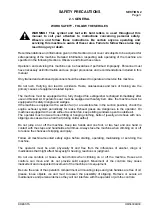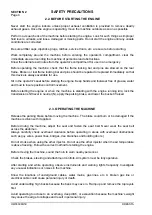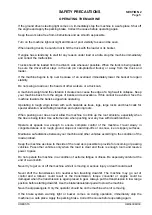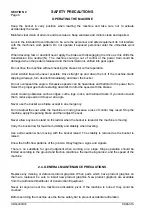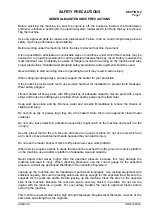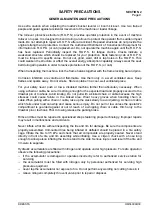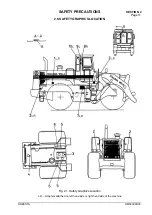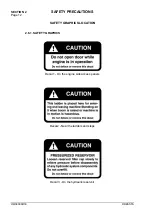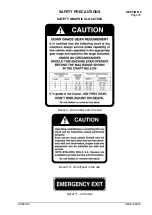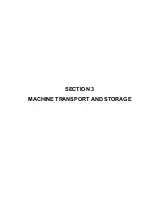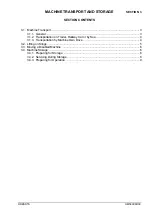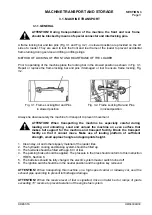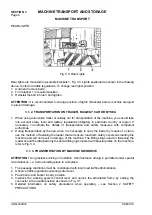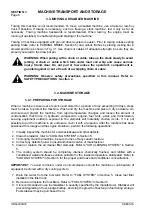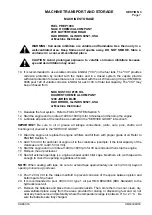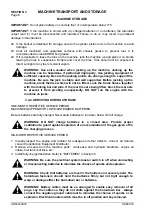
SAFETY PRECAUTIONS
SECTION 2
Page 9
DRESSTA
OM560C99/1E
GENERAL MAINTENANCE PRECAUTIONS
Use extra caution when adjusting the loader's bucket leveler or boom kick-out. Use two trained
people and guard against accidental movement of the machine or loader linkage.
The roll-over protective structure (R.O.P.S.) provides operator protection in the event of machine
rollover or upset. It is designed to bend during a rollover to protect the operator from sudden impact
loads. Do not attempt to repair a R.O.P.S. after an accident. Repaired structures do not provide the
original strength and protection. Contact the Authorized Distributor of Construction Equipment for
information on R.O.P.S. (or cab) replacement. Do, not operate the machine again until the R.O.P.S.
has been replaced. Periodically inspect the R.O.P.S. for fatigue cracks. Cracks indicate a
weakened structure which should be replaced for your protection. Bolts fastening cab or R.O.P.S.
must be torqued to specific value. Do not cut, grind, weld, drill or tap holes in the R.O.P.S. This
could weaken the structure or affect the overall energy absorption capability. Always wear the seat
belt during all operation in order to realize protection of the R.O.P.S.( or cab)
When transporting the machine, lock the frame halves together with the frame locking bar and pins.
Corrosion inhibitors are volatile and flammable. Use them only in a well ventilated area. Keep
flames and sparks away. Do not smoke. Store container in a cool, well ventilated place.
For your safety never push or tow a disabled machine farther than absolutely necessary. When
using a chain or cable, be sure it is strong enough for the expected load and properly secured to the
drawbar pin or towhook. Avoid kinking. Do not pull with a kinked chain or cable because the high
stresses could cause failure in the kinked area. Wear heavy gloves when handling chain or
cable.When pulling with a chain or cable, take up the slack slowly to avoid jerking. A chain or cable
which fails under load can whip and cause serious injury. Do not pull or tow unless the operator's
compartment is guarded against or out of reach of a whipping chain or cable. Hitch only to the
drawbar pin or towhook. Prior to towing release the parking brake.
Rims and tires must be repaired in specialized shops featuring proper technology. Improper repairs
may result in malfunctions and accidents.
Never inflate a flat tire without inspecting the tire and rim for damage. Be sure the components are
properly assembled. Unmounted tires being inflated or deflated should be placed in a tire safety
cage. Inflate the tire to 35 kPa and check that all components are properly seated. Never stand
directly in front of a tire and rim assembly while inflating. Use a clip-on chuck with a hose long
enough to allow person inflating the tire to stand to the side. Serious injure could result if the tire and
rim were to separate.
Hydraulic accumulators are filled with nitrogen and operate under high pressure. For safe operation
observe the following precautions:
−
if the accumulator is damaged or operates incorrectly refer to authorized service station for
servicing
−
the accumulator must be filled with nitrogen only by personnel authorized for servicing high
pressure equipment
−
never tap the accumulator nor expose to fire. Do not perform any welding nor cutting holes in it
−
relieve nitrogen completely thru vent valve prior to repair or disposal.
Summary of Contents for 560C
Page 1: ...OM560C99 1E OPERATOR S MANUAL 560C SERIAL NUMBERS 15001 AND UP ...
Page 3: ......
Page 5: ......
Page 7: ......
Page 10: ...SECTION 1 INTRODUCTION ...
Page 12: ......
Page 16: ...SECTION 2 SAFETY PRECAUTIONS ...
Page 18: ......
Page 32: ...SECTION 3 MACHINE TRANSPORT AND STORAGE ...
Page 34: ......
Page 42: ...SECTION 4 OPERATING ...
Page 43: ......
Page 45: ......
Page 49: ...SECTION 4 OPERATING Page 6 OM560C99 1E DRESSTA UNIVERSAL SYMBOLS FOR INSTRUMENTS AND CONTROLS ...
Page 88: ...SECTION 5 MAINTENANCE ...
Page 141: ...SECTION 6 SPECIFICATIONS ...
Page 143: ......









